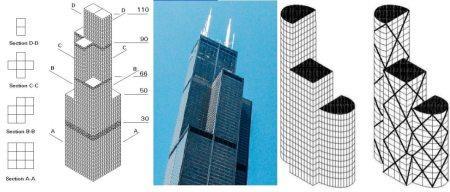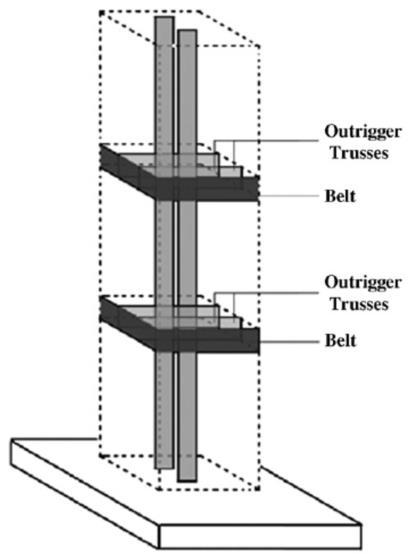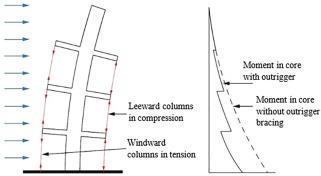

Comparative Study of Seismic Analysis of RC Frame Structure with and without Belt Truss and Outrigger Truss: A Review
AtulKumar1 , Mr. Ushendra Kumar2
1M.Tech, Civil Engineering, Lucknow Institute of Technology, Uttar Pradesh, India
2 Assistant Professor, Department of Civil Engineering, Lucknow Institute of Technology, Uttar Pradesh, India ***
Abstract - This reviewstudyprovidesathoroughanalysisof the seismic behavior of Reinforced Concrete (RC) frame structures, both with and without the use of Belt Truss and Outrigger Truss systems. The design and construction of buildings in earthquake-prone zones must prioritize seismic resistanceandstructuralintegrity.Theresearchaimstoassess the effectiveness of two commonly used lateral load-resisting methods, namely Belt Truss andOutrigger Truss,inimproving the seismic performance of reinforced concrete frame buildings. Thearticleconductsacomprehensiveanalysisofthe current body of literature, techniques, and analytical approaches used to research seismic behavior. It emphasizes important discoveries and patterns in this subject. The study examines and highlights the differences in seismic behavior between reinforced concrete (RC) frame buildings designed conventionally and those that use Belt Truss and Outrigger Truss systems. The evaluation involves examining the structural parameters, material properties, and dynamic analytic methodologies usedtoevaluatetheseismicresistance of certain structural configurations.
The research examines how parameters like as building height, structural geometry, and seismic loading characteristics affect the performance of RC frame buildings, bothwithand without extra truss systems. Thepurpose ofthis study is to provide helpful insights for structural engineers, researchers, andpractitionerswhoareengagedintheseismicresistant design and retrofitting of structures. This research enables educated decision-making in optimizing the seismic performance of reinforced concrete (RC) frame structures by recognizing their strengths and limits. Ultimately, this enhances the resilience and safety of buildings when exposed to seismic pressures.
Key Words: Seismic AnalysisReinforcedConcreteFrame,Belt Truss, Outrigger Truss, Comparative Study, And Dynamic Analysis.
1. INTRODUCTION
Ahigh-riseRC(ReinforcedConcrete)Frameisastructural method often used in the construction of tall structures, providingrobustness,longevity,andadaptability.Theframe is composed of reinforced concrete components that are linkedverticallyandhorizontally.Reinforcedconcreteisa composite material that combines concrete and steel. Columns serve as vertical supports, whereas beams distribute weights and link the columns. This structure is
crucialforresistingthestressesimposedbygravity,wind, andseismicactivity.
The building procedure entails encasing steel reinforcing barswithpouredconcrete,resultinginasturdyanddurable structure. High-rise reinforced concrete (RC) frames are highly preferred due to their capacity to withstand significant vertical loadsandprovideversatilityindesign. Architects can design inventive and visually appealing buildingswhilestillguaranteeingtheirstructuralsoundness. Engineersmeticulouslyconstructtheseframeworkstofulfill preciseloadandsafetycriteria,takingintoaccountvariables such as the height of the structure, occupancy, and local climatic conditions. Regular inspections and maintenance are essential for guaranteeing the ongoing stability and safetyofhigh-risereinforcedconcreteframesduringtheir lifetime. These constructions have a crucial impact on contemporary urban environments, enabling the construction of distinctive and practical skyscrapers throughouttheglobe.

2. BELT AND OUTRIGGER TRUSS IN RC FRAME STRUCTURE
In a Reinforced Concrete (RC) Frame Structure, belt and outriggertrussesarekeycomponentsdesignedtoenhance

the overall stability and lateral resistance of high-rise buildings. These elements play a crucial role in mitigating theeffectsoflateralforcessuchaswindandseismicloads. The belt truss is a horizontal truss typically located at or nearthemid-heightofabuilding.Itencirclesthestructure andservestoredistributelateralloads,preventingexcessive sway and promoting uniform distribution of forces to the vertical elements. This results in increased stiffness and overallstability.
Outrigger trusses, on the other hand, are inclined or horizontalstructuralelementsthatconnectthecoreofthe building to the exterior columns. These trusses extend beyondthebuildingperimeterandactasbraces,effectively tyingthecoreandtheexteriorcolumnstogether.Outriggers arestrategicallypositionedatdifferentheightstocreatea balancedforcedistribution,enhancinglateralstabilityand reducingstructuraldeformations. Thecombinationofbelt andoutriggertrussesinanRCframestructuresignificantly improves its resistance to lateral forces, making it more resilientinthefaceofexternalpressures.Engineerscarefully analyzeanddesignthesetrussestoensurethatthestructure meetsstringentsafetystandards,providingoccupantswitha secureandstable environment, especiallyintallbuildings wherelateralforcesaremorepronounced.

2.1 Purpose of Belt and Outrigger Truss in the Structure
The belt and outrigger trusses in a structure serve to enhance its overall stability and resilience against lateral
forces, such as wind and seismic loads. The belt truss, positioned at or near the mid-height, helps redistribute lateralloads,minimizingsway,andensuringamoreuniform distribution of forces on the structure. Outrigger trusses, connecting the core to exterior columns, act as braces, balancing forces and reducing deformations caused by lateralloads.Together,theseelementssignificantlyimprove thestructure'sabilitytowithstandexternalforces,ensuring safetyandstability.
2.2 Technique for improving the stability of the RC Frame Structure
Toenhancethestabilityofareinforcedconcrete(RC)frame structure, several key techniques can be employed. Incorporating shear walls strategically throughout the building,particularlyatitsperipheryandcore,isessential. Shear walls effectively resist lateral loads, contributing significantly to stability, especially in seismic regions. Additionally, implementing bracing systems, such as diagonalorX-bracing,enhanceslateralstiffness,distributing loadsandpreventingsway.Ensuringductilityinthedesign allowscontrolleddeformationduringseismicevents,while meticulous detailing of reinforcement, including ties and spirals,enhancesthestructure'sabilitytowithstandlateral forces.Properfoundationdesign,consideringsoilconditions andseismicparameters,iscrucial,asitpreventsdifferential settlements and contributes to overall stability. Adequate column design, utilizing sufficiently sized columns with proper detailing, is also imperative. Consideration of base isolation systems can further reduce lateral forces transmittedduringearthquakes.Diaphragmaction,where floorslabsactashorizontaldiaphragms,aidsindistributing lateralloads.Regularmaintenance,high-qualityconstruction materials,andadvancedanalysistechniques,suchasfinite element analysis, play integral roles in ensuring the durability and stability of the RC frame structure. This holisticapproach,coupledwithconsultationwithstructural engineersandadherencetobuildingcodes,isparamountfor achievingandmaintainingstructuralstabilityovertime.
2.3 Principle of the Belt and Outrigger Truss
The concepts of the Belt Truss and Outrigger Truss entail strategicallyintegratingstructuralcomponentstoimprove the stability of structures, especially when subjected to lateral pressures like wind or seismic stresses. The Belt Truss utilizes a configuration of horizontal and diagonal trusses organized in a belt-shaped framework around the outside edge of a building. This structure functions as a resilient support system, efficiently dispersing horizontal stresses and reducing excessive motion. Conversely, the Outrigger Truss system employs horizontal outrigger componentsthatstretchfromthecoreofthestructuretothe exteriorcolumns.Thesecomponentsarejoinedbydiagonal trusses. This design promotes the equitable dispersion of horizontal stresses, improving the overall structural robustnessoftallstructures,particularlyinareassusceptible

tostrongwindsorseismicevents.BoththeBeltTrussand Outrigger Truss systems demonstrate inventive technical ideasdesignedtostrengthenstructuresagainstthelateral forcestheyface.

3. LITERATURE REVIEW
Inthissectionoftheliteraturestudy,wehaveexaminedthe previous research work that was concerned with the enhancement of the high-rise structure using a variety of techniques.Belowisasummaryofallofthepriorresearch papersthathavebeenpublished:
Bayati et.al: The exploration of outriggers for high-rise structureshasconsideredbothbelttrussesandbasements. Belttrusses,whenemployedasoutriggers,offeradvantages similar to traditional outriggers without their associated drawbacks.Ontheotherhand,basementsusedasoutriggers can provide a broader and more stable foundation, enhancing resistance to tipping. An illustrative example showcases the effective use of belt trusses as virtual outriggers, demonstrating the overall effectiveness of the outriggerconcept.However,thestudynotesthatthelower stiffness of the indirect force transfer mechanism makes traditional direct outriggers more effective than virtual outriggerswithidenticalcolumnsizesandplacements.
Kiran et.al: Basedonthefindingsofthisinvestigation,itis concluded that high-rise structures experience enhanced structural rigidity and improved lateral load efficiency throughtheincorporationofoutriggersandbelttrusses.The utilizationoftheseelementsreducesthemaximumdriftat thestructure'stop,particularlyevidentwhenemployingthe rightlateralsystem.Specifically,theplacementofacaptruss outriggerresultsinamaximumdriftof48.20mmwithabelt trussand47.63mmwithoutone,indicatingminimalimpact on drift reduction by the belt truss. Introducing a second outriggerwithacaptrussreducesthestructure'sweightby 18.55percent,whiletheabsenceofabelttrussresultsina weightreductionof23.01percent.Theoptimallocationfor
thesecondoutriggerisdeterminedtobeatthecenterofthe structure,withtheidealplacementfallingbetween0.5and 1.5timesitsheight.
Daril et.al: To ensure consistency and meaningful comparisons, only results generated by the program's computed period are considered. Buildings utilizing exclusivelybelttrussesdemonstratesuperiorperformance intermsofbaseshearandlateralstressescomparedtothose relyingsolelyonoutriggersoracombinationofoutriggers and belt trusses. outperforming structures with only outriggers.Additionally,intermsofdriftbetweenfloors,a structureemployingbothoutriggersandabelttrusssystem surpassesbuildingsequippedwitheithersysteminisolation.
Sandesh et.al: To analyze temporal patterns, outriggers werestrategicallyplacedonthe15th,20th,and30thfloors. Introducing outriggers on the 20th floor significantly minimized the building's displacement, decreasing from 81.59 mm to 17.31 mm. Without outriggers, the speed dropped from 68.72 mm/sec to 59.48 mm/sec, while the acceleration increased from 231.86 mm/sec² to 622.43 mm/sec². The base force, in the absence of outriggers, decreasedfrom1873.35kNto110.52kN.Notably,theuseof outriggersenhancedthebuilding'sstorystiffnessbyafactor of 2.27 when compared to a configuration without outriggers. Compared to a building lacking outriggers, a structureequippedwiththemdemonstrateda34.1percent reduction in maximum storey displacement and a 19.7 percent reduction in maximum storey shear. Additionally, theoverturningmomentinastructurewithoutriggerswas foundtobereducedby17.18%whencomparedtoabuilding withoutoutriggers.
Bishal et.al: Whenutilizedtogether,outriggersanddampers contributetoenhancedrigidityandincreasedefficiencyof theauxiliaryframeintallbuildingssubjectedtolateralloads. Themaximumdriftatthetoplevelsignificantlyinfluences tenant comfort and plays a crucial role in realizing the structural vision. An analysis of five model buildings revealedthatthecombinationofoutriggerbelttrussesand damperscanimproveabuilding'sseismicperformanceby reducinglateraldisplacementduringseismicgroundmotion. Notably,structures equippedwithdamperssurpassthose with outrigger belt truss frames in terms of seismic performance.Additionally,buildingsemployingdampersfor energydissipationexhibitmoreconsistentinter-storydrift comparedtothoserelyingonoutriggerbelttrussframes.
Premalatha et.al: Through a comprehensive analysis involvingtimehistoryandresponsespectrumanalyses,the optimalplacementofanoutriggerbelttrusssystemina30story reinforced concrete irregular structure was determined. Performance metrics, including storey displacements,drifts,andaccelerations,wereevaluatedfor all frame models. The RC frame incorporating two belt trusses, positioned at 0.6h and 0.4h, outperformed other models. This configuration exhibited a notable 28.93%

reductioninmaximumdisplacementcausedbywindforces, along with decreases of 13.23% and 15.5% in response spectrumanalysisandstaticearthquakeforces,respectively, comparedtothebareframe.Theheightenedrigidityofthe building structure was evident in the reduced story drifts observedinthisframewithtrussesattwolevels.
İbrahim et.al: The research revealed that the addition of outrigger and belt-truss systems to a shear-wall framed structure resulted in a reduction in translational and torsionalperiods,leadingtoimprovedlateralandtorsional rigidity. Outrigger systems proved more influential in enhancing lateral stiffness, while belt-truss systems were more significant for torsional stiffness. Incorporating outriggers into a shear wall-framed system effectively minimized horizontal displacements under lateral static stresses. However, in dynamic analysis, the lateral displacements were not reduced as much as predicted by staticanalysisfindings.Thisdiscrepancyishypothesizedto be influenced by dynamic reactions, considering the structure's stiffness, mass, damping, and ground motion features.Theoutriggersandbelttrusseswereobservedto reduce lateral drifts in the attached stories by enhancing theirlateralrigiditythroughstrategicplacement.
4. CONCLUSION
Tosummarise,thecomparativeanalysisofseismicanalysis discussed in this review article provides valuable insights into the substantial influence of integrating belt truss and outrigger truss systems in reinforced concrete frame buildings. The thorough examination of the structural performance under seismic stresses has shown that these inventive structural components have a vital impact on improving the overall seismic resistance and stability of reinforced concrete frame constructions. The results emphasizethatincorporatingbelttrussandoutriggertruss systems results in significant enhancements in lateral stiffness,decreasedinter-storydrifts,andimprovedenergy dissipation capacity. The beneficial results are credited to the efficient dispersion of horizontal forces, leading to a moreequitabledistributionoftheloadinsidethestructure. Furthermore, the analysis highlights the significance of meticulous evaluation of many design factors, including trussgeometry,materialqualities,andconnectiondetails,to enhance the seismic performance of reinforced concrete framestructures.Bothbelttrussandoutriggertrusssystems possessnotableearthquakemitigationqualities.However, the selection between them should be based on project objectives, site circumstances, and design limitations. Furtherresearchinthisdomainmightexploreparametric analyses,takingintoaccountvariousbuildingarrangements and degrees of seismic risk, to get a more nuanced comprehensionoftheperformanceofreinforcedconcrete framebuildingsequippedwiththesetrusssystems.
REFERENCE
1. Z.Bayati1,M.Mahdikhani2andA.Rahaei3(2008) “Optimized Use Of Multi-Outriggers System To StiffenTallBuildings”The14thWorldConference on Earthquake Engineering October 12-17, 2008, Beijing,China.
2. P.M.B. Raj Kiran Nanduri1 , B.Suresh2 , MD. Ihtesham Hussain3 (2013) “Optimum Position of OutriggerSystemforHigh-RiseReinforcedConcrete Buildings Under Wind And Earthquake Loadings” AmericanJournalofEngineeringResearch(AJER)eISSN 2320-0847 p-ISSN: 2320-0936 Volume-02, Issue-08,pp-76-89.
3. Daril John Prasad1 , Srinidhilakshmish Kumar2 (2016) “Comparison Of Seismic Performance Of OutriggerAndBeltTrussSystemInARccBuilding With Vertical Irregularity” IJRET: International JournalofResearchinEngineeringandTechnology eISSN:2319-1163|pISSN:2321-7308.
4. SandeshKumarShiroleY1Dr.B.KRaghuPrasad2 Dr. Amarnath K3 (2016) “Study Of Behavior Of Outriggers In A High Rise Building Under Seismic Loading” International Research Journal of EngineeringandTechnology(IRJET)e-ISSN:23950056Volume:03Issue:08|Aug-2016.
5. 1Ajinkya Prashant Gadkari, 2N. G. Gore (2016) “BehaviourofOutriggerStructuralSysteminHighRise Building” 2016 IJEDR | Volume 4, Issue 2 | ISSN:2321-9939.
6. Bishal Sapkota (2017) “Comparative Study On Seismic Performance Of High-Rise Building With Energy Dissipation And Outrigger Belt Truss System”InternationalJournalofCivilEngineering and Technology (IJCIET) Volume 8, Issue 4, April 2017,pp.1539-1545,ArticleID:IJCIET_08_04_173.
7. Premalatha J, Mrinalini M (2018) “Seismic BehaviourofaMulti-storeyedReinforcedConcrete IrregularBuildingwithOutriggerBelttrussSystem” InternationalJournalofEngineeringandAdvanced Technology(IJEAT)ISSN:2249–8958,Volume-8, Issue-2S,December2018.
8. İbrahimÖzgürDedeoğlu*1,YusufCalayır2(2020) “Effectiveness of outrigger and belt truss systems on the seismic behavior of high-rise buildings” Journal of Structural Engineering & Applied Mechanics2020Volume3Issue3Pages180-203.
9. G. Ranganayagi1 and J. Premalatha2 (2020) “Tall BuildingswithOutriggerandBeltTrussSystemas the Lateral Load Resisting System” International Journal of Advanced Research in Science, CommunicationandTechnology(IJARSCT)Volume 11,Issue2,November2020.
10. Urjal Das1 , Ankit Pal2 , Arvind Vishwakarma3 (2020) “Behavior of Outrigger Wall and Wall Belt Supported System under Lateral Loads in a Structure” International Journal of Advanced

EngineeringResearchandScience(IJAERS)[Vol-7, Issue-8,Aug-2020].
11. VandanaVirde(2021)“EffectsofOutriggeronHighRise Structure” IJSTE - International Journal of Science Technology & Engineering | Volume 8 | Issue1|July2021ISSN(online):2349-784X.
12. Nilesh B Mahale1 , Pallavi Pasnur2 , Navnath Khadake3(2021)“TheEfficientUseOfAOutrigger AndBeltTrussInTall Buildings”2021JETIRMay 2021,Volume8,Issue5.
13. ShamanthN(2021)“OutriggerStructuralSystemin High-Rise Building” International Journal of ResearchinEngineeringandScience(IJRES)ISSN (Online): 2320-9364, ISSN (Print): 2320-9356 www.ijres.orgVolume9Issue8ǁ2021ǁPP.78-86.
14. PankajPatel1,RahulSharma(2021)“Comparative AnalysisofWallBeltSystems,ShearCoreOutrigger Systems and Truss Belt Systems on Residential Apartment” International Journal of Research Publication and Reviews Journal homepage: www.ijrpr.comISSN2582-7421.
